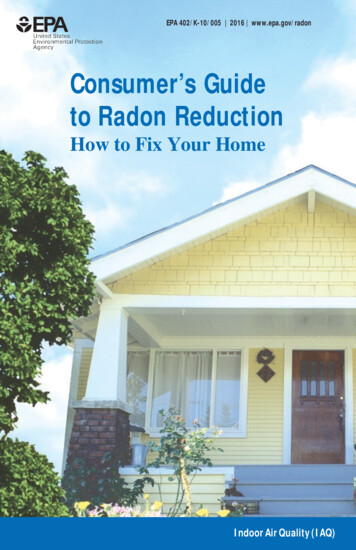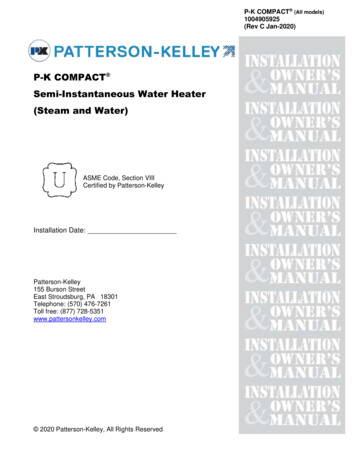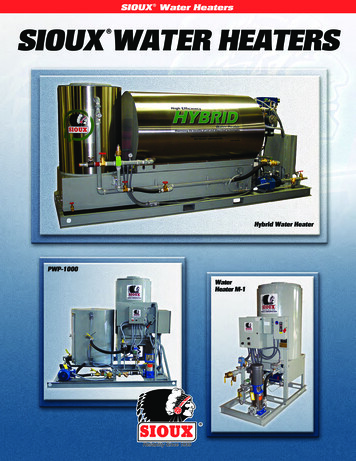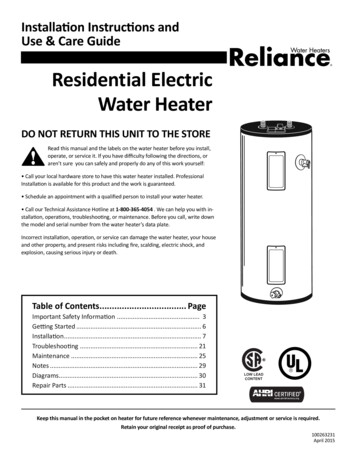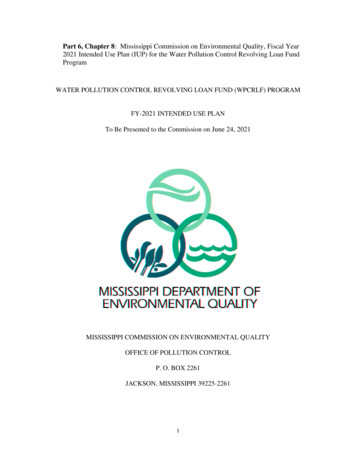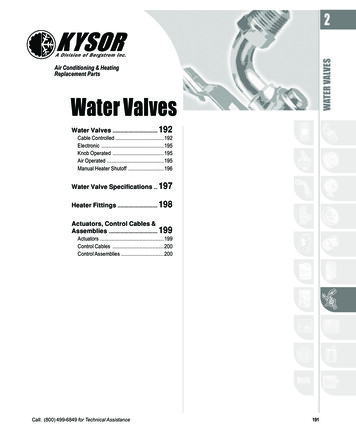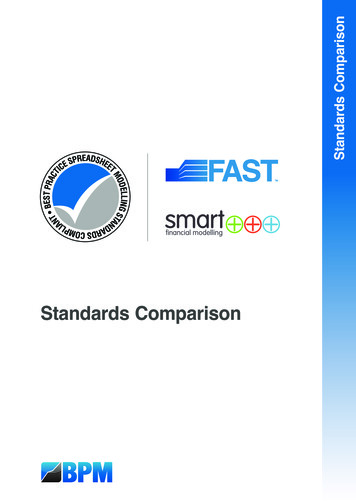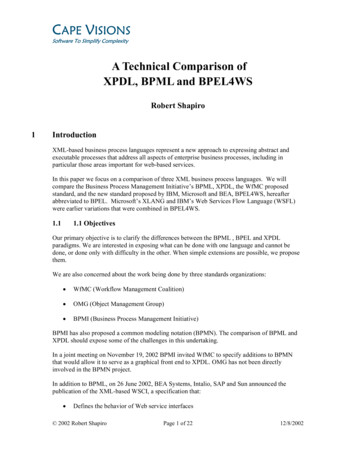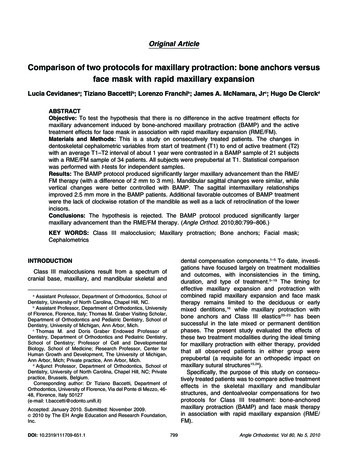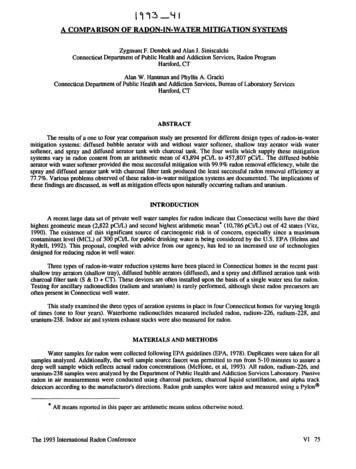
Transcription
A COMPARISON OF RADON-IN-WATER MITIGATION SYSTEMSZygmunt F. Dembek and Alan J. SiniscalchiConnecticut Department of Public Health and Addiction Services, Radon ProgramHartford, CTAlan W. Hanlman and Phyllis A. GrackiConnecticut Department of Public Health and Addiction Services, Bureau of Laboratory ServicesHartford, CTABSTRACTThe results of a one to four year comparison study are presented for different design types of radon-in-watermitigation systems: diffused bubble aerator with and without water softener, shallow tray aerator with watersoftener, and spray and diffused aerator tank with charcoal tank. The four wells which supply these mitigationsystems vary in radon content from an arithmetic mean of 43,894 pCi/L to 457,807 pCi/L. The diffused bubbleaerator with water softener provided the most successful mitigation with 99.9% radon removal efficiency, while thespray and diffused aerator tank with charcoal filter tank produced the least successful radon removal efficiency at77.7%. Various problems observed of these radon-in-water mitigation systems are documented. The implications ofthese findings are discussed, as well as mitigation effectsupon naturally occurring radium and uranium.INTRODUCTIONA recent large data set of private well water samples for radon indicate that Connecticut wells have (lie thirdhighest geometric mean (2,822 pCi/L) and second highest arithmetic mean* (10,786 pCi/L) out of 42 states (Vitz,1990). The existence of this significant source of carcinogenic risk is of concern, especially since a maximumcontaminant level (MCL) of 300 p C f i for public drinking water is being considered by the U.S.EPA (Helms andRydell, 1992). This proposal, coupled with advice from our agency, has led to an increased use of technologiesdesigned for reducing radon in well water.Three types of radon-in-water reduction systems have been placed in Connecticut homes in the recent past:shallow tray aerators (shallow tray), diffused bubble aerators (diffused), and a spray and diffused aeration tank withcharcoal filter tank (S & D CT). These devices are often installed upon the basis of a single water test for radon.Testing for ancillary radionuclides (radium and uranium) is rarely performed, although these radon precursors areoften present in Connecticut well water.This study examined the three types of aeration systems in place in four Connecticut homes for varying lengthof times (one to four years). Waterborne radionuclides measured included radon, radium-226, radium-228, anduranium-238. Indoor air and system exhaust stacks were also measured for radon.MATERIALS AND METHODSWater samples for radon were collected following EPA guidelines (EPA, 1978).Duplicates were taken for allsamples analyzed. Additionally, the well sample source faucet was permitted to run from 5-10 minutes to assure adeep well sample which reflects actual radon concentrations (McHone, el al, 1993). All radon, radium-226, anduranium-238 samples were analyzed by die Department of Public Health and Addiction Services Laboratory. Passiveradon in air measurements were conducted using charcoal packets, charcoal liquid scintillation, and alpha trackdetectors according to the manufacturer's directions. Radon grab samples were taken and measured using a pylonB* All means reported in this paper are arithmetic means unless otherwise noted.The 1993 International Radon Conference
model AB-5 radiation monitor. Gamma radiation was determined with a udlum@model 19 radiation detector andan berline@model R02 radiation detector.Three types of radon in water mitigation systems were evaluated: diffused bubble aerator both with andwithout an attached water softener, shallow tray aerator with water softener, and a spray and diffused aerator tankwith charcoal tank. All four devices examined were located in the basement of each house. The diffused bubbleaerator consists of a 32" x 17.5" x 43.5" three stage diffused bubble aerator tank; one of the systems studied isconnected to a water softener (WS). The shallow tray aerator uses forced draft countercurrent air stripping throughbaffled aeration in a 28" x 36" tank. The spray and diffused aerator tank consists of a 62" x 33" fiberglass tank intowhich water passes through a combination of spray and diffused aeration. There is a charcoal filter tank (CT)attached to the spray and diffused aerator tank.Each type of device, and period of time studied, is seen in Table 1 below, along with the number of samplescollected.RESULTSThe data in Table 1 presents the relationship between the well number, mitigation system installed, the rangeof sampling dates and Uie number of samples collected throughout this study. Samples were taken over a period offrom one to four years, dependent upon the time of recruitment of (lie homeowner into (lie study. Efforts was madeto collect samples upon a monthly basis.Table 1. Outline of well study sampling parameters.WELL#TYPE -DiffusedDiffused WSShallow Tray WSS&D CT1234SAMPLING DATES# OF SAMPLES COLLECTED2/92- 1/934/90-6/936/89-619311191-6/939264425The well sampling data both describes and limits knowledge of the well's inherent radionuclide fluctuations.The four mitigation systems examined were installed in order to mitigate radionuclides in water. Each well hasinherently different levels of radionuclides which fluctuated about a mean value. These arithmetic mean values forthe various radionuclides examined are depicted in Table 2 below.Table 2. Mean levels of pre-mitigation well radionuclides (pCi/L,).The data in Table 2 shows that all of (lie wells have radon present in amounts which may warrant mitigation.Associated with the radon levels in all of these wells are measurable amounts of the antecedent radionuclidesuranium and radium. Measurable radium228 has not been exhibited in these wells. The two highest wells also haveuranium in excess of 7 pCi/L.In Table 2, well #2 is seen to demonstrate (lie highest mean value for radon out of (lie four wells studied, andthe second highest values for radium and uranium. Well #1 had the lowest values for radon and radium. Well #3of mitigation system installed with the well.* TypeEach well is mitigated by a different system as described in Table 1.fRadon values are x lo3.The 1993 International Radon Conference
which has the second highest mean for radon, and the highest mean for radium and uranium, while well #4 had thesecond lowest radon and radium mean value, and lowest uranium value.Table 3. Pre-mitigation well radionuclide ranges (pCi/L).Table 3 characterizes the intrinsic well radionuclide ranges prior to mitigation system effects. Largefluctuations in radionuclide levels are present in most of these wells, as is seen by their ranges and variance values inTable 4.Table 4. Variance of pre-mitigation well radionuclides (pCi/L).Tables 5 and 6 show the effects of the various mitigation systems upon the radionuclides present in me wellsstudied.Table 5. Mean levels of post-mitigation well radionuclides (pCi/L).I.mEDiffusedDiffused WSShallow Tray WSS&D 100.0100.025.0Table 6. Efficiency of mitigation (96).TYPEDiffusedDiffused WSShallow Tray WSS&D CT96.699.1Table 7 presents the results of radon air sampling at the discharge pipe for the aeration system, and comparesthese results to radon water values at the approximate time of sampling.11 Ratio oflower limit of the range to the upper limit.Not detected.The 1993 International Radon Conference
Table 7. Stack sampling at discharge pipe of aeration system ( p i / ) xx!?EDiffusedDiffused WSShallow Tray WSS&D CTStack Rn-222(oCi/L)3,4408,OOO1,5406,450Water Rn-222(DC /L)**48.9400.8513.6243.4ImationGround LevelRooftopGround LevelRooftopDISCUSSIONAs seen in Table 2, three of (he four wells studied, with the exception of the well #2, have radium-226 inexcess of current public drinking water regulations (Dupuy, et al, 1992). Should the a homeowner desire to use theEPA Safe Drinking Water Act (SDWA) as guidance for radionuclide acceptability, and the lowest radium maximumcontaminant level (MCL) under consideration by EPA be enacted (2 pCi/L), all of the wells would requireremediation for this radionuclide (Dupuy, el al, 1992). At present, (lie lowest MCL for uranium being considered bythe EPA under SDWA is 5 pCiA (Dupuy, et al, 1992). The two highest wells in this study have uranium levels inexcess of this proposed MCL.Figure 1 below depicts a comparison of radon levels before and after the effects of each mitigation system. Itis derived from the data in Tables 2 and 5. The most significant radon reduction was achieved by (lie diffused bubbleaerator WS system, followed closely by the shallow tray aerator WS and diffused bubble aerator systems. Thesnrav and diffused aerator tank CT system removed the least amount of radon; all of these removal efficiencies areA n i n Table 6 above.Figure 1.IDAiudDAlled WSShillmTraywsS60Ã CTFIGURE 1. Pflf.AMD WSlJuncalION U M RMOMZZZ I M L SFigure 2 below depicts a comparison of radium levels before and after the effects of each mitigation system,as derived from the data presented in Tables 2 and 5. The two systems having water softeners, (lie diffused bubbleaerator WS and the shallow tray aerator WS, were able to remove most of the radium-226 present. The systemswithout water softeners, (lie diffused bubble aerator and the spray and diffused aerator tank CT. did not mitigatethe radium-226 present in the water supply. The post-mitigation increase in radium-226 may be an artifact oflaboratory analysis.# Results ofstack.ihe average of 10 one minute grab samples during the apex of radon emissions from the top of the* Pre-mitigation water sample taken at about the same time and date of the air sample. These radon in watervalues are x 103.The 1993 International Radon Conference
Figure 2.DausriDflJied*WSShtllwTnywsS&D CTFIGUUE 2. PHIAMD POSTÂ lUTIGAM MEAN RAUIUH.27G LEVFLSFigure 3 below demonstrates the results of each mitigation system upon uranium levels in each well, as takenfrom the data presented in Tables 2 and 5. Similar to their effects upon radium, (lie two of the systems which hadwater softeners connected to them (the diffused bubble aerator and (lie shallow tray aerator systems) were able toremove all of the uranium-238 present. As expected, the systems without water softeners, a diffused bubble aeratorand the spray and diffused aerator tank CT, had little effect upon the uranium-238 present in (lie water supply. It ispossible that the removal efficiency of this radionuclide in die diffused bubble aerator and (lie spray and diffusedaerator tank CT systems is an artifact of the small levels measured, which are near the limit of detection as attainedin the laboratory.Figure 3.As implied by Table 3 and Figures 1 through 3, the mitigation systems are tasked to address radionuclidefluctuations which are not apparent to the homeowner after a single round of sampling. A single sample of any ofthese wells does not address the significant variations about a mean value which can occur. We liave previouslydocumented the inadequacy of a single water sample to assess radon levels in well water (Siniscalchi, el al, 1993).The least radon variance observed (16,800 PC&) was in well #1, to which is attached Uie diffused bubbleaerator system, while the spray and diffused aerator WS system was (asked to mitigate a well (#3) with a radonvariance of 208,200 PC&. The ratio of the lower to upper limit of (lie range of radon value also demonstrates amuch greater ratio in wells #3 (1: 19.3) and #4 (1:7.5) than that of wells #1 (1:2.0) and #2 (1: 1.6).'Hie well exhibitingthe most stable radon values had the highest overall mean radon value (#2) and was mitigated with the diffusedbubble aerator WS system.A homeowner receiving a sample value for radon at the lower end of the radionuclide ranges shown in Table3 may be surprised by sampling data demonstrating the higher end of values. A mitigation system choice can beThe 1993 International Radon Conference
made based upon the lower end of sampling data which would not appropriately mitigate higher radon levels orradium or uranium in the well water.An examination of Tables 5 and 6 reveals that the most effective system in this study with respect to radonremoval is the diffused bubble aerator WS, which brought the well having the greatest overall mean radon level toless than 250 p C i , a reduction of almost 100%. Both the diffused bubble aerator WS and the sliallow tray aerator WS achieved removal of virtually all radium and uranium from their respective wells. The spray and diffusedaerator tank CT achieved the least removal of all radionuclides among the systems studied.The data in Table 7 illustrate the importance of proper ventilation of water mitigation radon ventilation stacks.Fortunately, all systems were ventilated to prevent reentry of radon plumes into the home. The ground level slackswere ventilated at the crest of small hilltops away from the homes.Table 8. Efficiency of radon mitigation as applied to hypothetical wells.TYPEDiffusedDiffused WSShallow Tray WSS&D CTRn-222(%)Efficiency #196.299.999.477.7107317629f&uEfficiencv #2{DCVI,)7,900300,00050,0001,345Table 8 demonstrates what the results would be of applying each of the mitigation systenis studied tohypothetical wells. Efficiency #1 demonstrates the results of applying each mitigation system to an averageConnecticut well of 2,822 pCi/L. Efficiency #2 shows the highest radon value which could be present in a well andsuccessfully mitigated with each mitigation system to 300 pCi/L. In the event of an EPA SDWA national publicdrinking water standard for radon of 300 pCiL the four mitigation systems studied would have varying success inachieving this standard. Assuming an average radon level in Connecticut of 2,822 pCi/L, three of the four systemsstudied (diffused bubble aerator with and without water softener, shallow tray aerator with water softener) wouldreduce the radon to less than 300 pCi/L. The spray and diffused aeration lank with CT system would be unable toachieve this level of mitigation. As demonstrated by the efficiency #2 values, the spray and diffused aeration tankwith CT is the single mitigation system which cannot successfully mitigate the average Connecticut well.PROBLEMS ENCOUNTERED WITH MITIGATION SYSTEMSDiffused Bubble AeratorAs expected, the diffused bubble aerator does not appear to greatly affect radium or uranium levels. The 20%reduction of uranium seen in Table 6 and Figure 3 may be an artifact of measurement of this low concentration. Airradon readings taken throughout the first floor and basement of the home throughout the sampling period withactivated charcoal detectors and charcoal liquid scintillation radon detectors, and radon grab samples using (liePylon@at no time exceeded (lie EPA guideline of 4.0 pCi/L.Diffused Bubble Aerator With Water SoftenerWhen combined with a water softener, the diffused bubble iterator did significantly reduce radium anduranium levels. However, when a radon mitigation system is connected to a well having high levels of otherradionuclides, problems may develop.During January and February of 1992, periodic radon measurements using 4 day charcoal liquid scintillationradon detectors revealed that radon levels in the basement of the home in which this mitigation system was placedwere elevated (7.5-10.2 pCi/L). Radon air measurements in the first floor of the house radon indicated levels of 1.33.3 pCi/L. Radon levels in previous months were below 4.0 pCi/L. Radon grab samples in the basenient initially didnot exceed 4.0 pCi/L. However, upon investigation it was determined that the source of (lie elevated radon airreadings was from a flexible plastic tubing which discharged wash liquid from the water softener tank into a verticalpipe which accepted wash water discharge. The liquid released from this tank was measured for radionuclides andwas found to contain 513,200 pCiL radon, 33.1 pCi/L radium-226, and 20 pCi/L uranium.'Hie 1993 International Radon Conference
The plastic tubing discharge was subsequently sealed air-tight to Uie pipe using plastic sheeting material andduct tape. This sealing of the plastic tubing discharge from the water softener tank has stopped the leak of radon intothe basement.Also during 1992, the water flow rate into household taps slowed considerably, and the homeowners shut offthe diffused bubble aerator with WS system for various time periods. In March, radon in air levels (using 4 daycharcoal liquid scintillation detectors) reached a high of 90.3 p C i i in the first floor bathroom and 23.0 pCi1L in thebasement during ihe time that the water mitigation system was turned off. It was determined that the prefilter to themitigation system had not been changed for (lie last two years, and had become saturated with particulate matter andbecome obstructed. The premier was changed, and the liquid from this filter contained 393,000 pCi/L radon, 481p C i radium, 52 pCiL uranium, and 38 pCi/L thorium.Gamma radiation readings taken in March of 1993 indicated that the water softener tank was emitting 1.5mWhr (closed window, background radiation 10 LiR/hr). Therefore, the water softener tank had become a sourceof radiation. It is reasonable to assume that prior to replacement, the prefilter had also been a source of radiation.Shallow Tray Aerator With Water SoftenerRadon air sampling data for the past three years has resulted in levels below 4.0 pCi/L. No problems havebeen encountered with the use of this system.Spray And Diffused Aerator Tank With Charcoal Filter TankRadon air sampling with passive detectors have resulted in levels below 4.0 pCi/L. However, radon grabsampling with the pylon@radiation monitor detected levels exceeding EPA guidelines both in the small basementroom where the spray and diffused aerator tank with CT is located (4.2 pCi/L), and directly on top of the bubbleaeration tank (10.0 pCi/L). Grab sampling readings taken throughout the rest of the basement and the house on fourseparate occasions throughout a one month winter period did not reveal radon readings in excess of EPA guidelines.Gamma radiation measurement taken during March of 1993 indicated that (lie charcoal tank was emitting 2.8mR/hr (closed window, background radiation 8 nR/hr). Therefore, the charcoal filter tank had become asource ofradiation.CONCLUSIONSAlthough limited by the fact that only four wells and one or two examples were examined for each type ofmitigation system, certain conclusions are warranted .The well sampling data emphasize (lie need to conduct multiple samples prior to a mitigation systemselection. Substantial variances were observed for the radionuclides studied (especially for radon) in the four wellssampled. We have observed up to a nineteen-fold difference in the lower and upper range limits for well waterradon.All systems studied accomplished radon removal of 77% or greater. Both the diffused bubble aerator andshallow tray aerator systems were most effective ( 96%) in removing radon from well water. Out of the systemsstudied, (lie diffused bubble aerator with and without water softener units, and the shallow tray aerator with watersoftener unit would achieve the proposed EPA SDWA public drinking water standard using the average well waterin Connecticut. The spray and diffused aerator tank with charcoal filter tank did not attain the level of performanceof the other systems, and may not mitigate the average Connecticut well successfully if held to the same standard.As expected, aeration systems appear not to be able to affect radium or uranium levels in water. Whencombined with a water softener, a diffused bubble aerator or shallow tray aerator may effectively remove allradionuclides present in well water. The spray and diffused aerator with charcoal
mitigation systems: diffused bubble aerator with and without water softener, shallow tray aerator with water softener, and spray and diffused aerator tank with charcoal tank. The four wells which supply these mitigation systems vary in radon content from an arithmetic mean of 43,894 pCi

